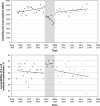Epidemiological interpretation of studies examining the effect of antibiotic usage on resistance
- PMID: 23554418
- PMCID: PMC3623381
- DOI: 10.1128/CMR.00001-13
Epidemiological interpretation of studies examining the effect of antibiotic usage on resistance
Abstract
Bacterial resistance to antibiotics is a growing clinical problem and public health threat. Antibiotic use is a known risk factor for the emergence of antibiotic resistance, but demonstrating the causal link between antibiotic use and resistance is challenging. This review describes different study designs for assessing the association between antibiotic use and resistance and discusses strengths and limitations of each. Approaches to measuring antibiotic use and antibiotic resistance are presented. Important methodological issues such as confounding, establishing temporality, and control group selection are examined.
Figures









References
-
- Rosenthal VD, Maki DG, Jamulitrat S, Medeiros EA, Todi SK, Gomez DY, Leblebicioglu H, Abu Khader I, Miranda Novales MG, Berba R, Ramirez Wong FM, Barkat A, Pino OR, Duenas L, Mitrev Z, Bijie H, Gurskis V, Kanj SS, Mapp T, Hidalgo RF, Ben Jaballah N, Raka L, Gikas A, Ahmed A, Thu LTA, Guzman Siritt ME. 2010. International Nosocomial Infection Control Consortium (INICC) report, data summary for 2003-2008, issued June 2009. Am. J. Infect. Control 38:95–104 - PubMed
-
- Baquero F, Negri MC, Morosini MI, Blazquez J. 1998. Antibiotic-selective environments. Clin. Infect. Dis. 27(Suppl 1):S5–S11 doi:10.1086/514916 - DOI - PubMed
-
- Harbarth S, Harris AD, Carmeli Y, Samore MH. 2001. Parallel analysis of individual and aggregated data on antibiotic exposure and resistance in gram-negative bacilli. Clin. Infect. Dis. 33:1462–1468 - PubMed
-
- Daniel W. 1940. The principles of chemotherapy in gonorrhea. South. Med. Surg. 102:114–115
-
- Rammelkamp C, Maxon T. 1942. Resistance of Staphylococcus aureus to the action of penicillin. Proc. Soc. Exp. Biol. Med. 51:386–389
Publication types
MeSH terms
Substances
LinkOut - more resources
Full Text Sources
Other Literature Sources
Medical

